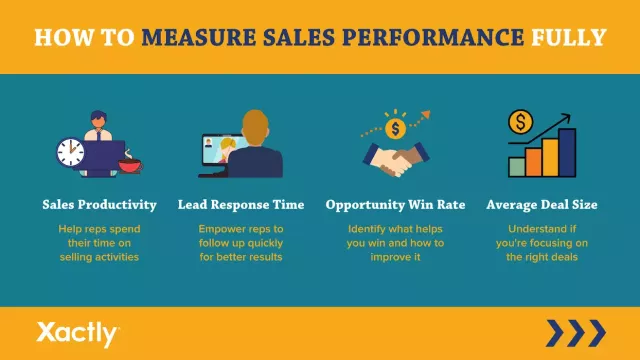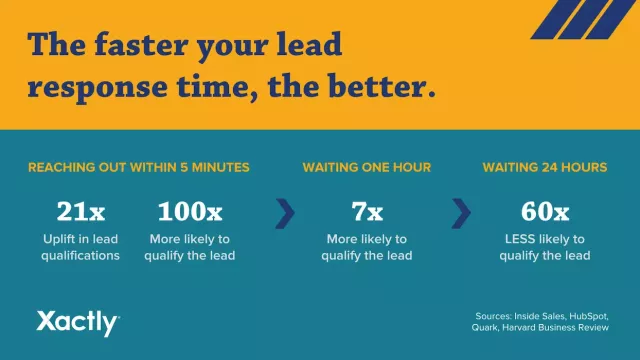How do you measure sales performance? Usually, the answers mentions traditional sales metrics such as goal achievement or quota attainment, but these aren't the only KPIs that impact performance. While they give a very high-level picture of overall sales performance, they don't show how each part of an organization is performing.
The Need to Measure Sales Performance Accurately
Leadership develops plans to reach its goals—but what are those decisions based on? More often than not, they're based on a gut instinct. Here's why this is bad.
When decisions are based on instinct and what leaders think will happen, they aren't based on fact. This means every part of the sales plan, forecast, etc. is a best guess. Think of this in terms of your paycheck. What if the payroll department paid you based on how much they expected you to work? Chances are you'd be pretty concerned that their decisions would be based on a guess and not on what you deserved to be paid.
The same applies to sales planning. You can't base company strategy on gut instinct alone and expect performance to meet your expectations. It's unrealistic. You need to use KPIs in your sales data strategically alongside experience to make well-informed decisions and design accurate plans.
So what sales metrics do you need to measure performance fully and completely? Here are four metrics to track to ensure you measure sales performance accurately.
1. Sales Productivity Metrics
How much time do your reps spend selling? Sales productivity is key for leadership to understand because time spent selling helps measure sales performance in terms of efficiency.
Average-performing sales reps spend only about 35 percent of their time in direct selling, and 65 percent dealing with non-selling activities. These time sinks include non-sales calls and internal conversations/meetings, or even networking. All of these activities seem harmless on the surface, but like all things, they add up.
According to Hubspot, salespeople who spent more time on sales-related activities enjoyed their jobs more. In fact, there was a notable jump in job satisfaction between reps who spent three hours or less on sales-related activities and those who spent four or more hours each day on sales-related tasks. Those who spent four or more hours on sales work rated their job satisfaction at a 3.8 out of five.
Once you know the causes, you can take steps to eliminate the barriers and increase sales productivity. To become a more strategic organization and operate more efficiently.
2. Lead Response Time
Time is valuable when you’re looking at how long it takes reps to follow up on leads. The longer your lead response time, the lower your performance is.
Here's a breakdown on how time impacts the success of lead conversion:
- Inside Sales notes that reps experience a “21x uplift in qualifications” if they reach out within five minutes compared to 30 minutes.
- Hubspot says those who perform outreach within five minutes are “100 times more likely to qualify the prospect.”
- If you contact with the lead within receiving it, you might be seven times more likely to qualify the lead than if you were to wait another hour.
- Don’t wait a full 24 hours or else you might be 60 times less likely to qualify the lead.
Think about the resources that go into creating leads from marketing and other areas. Capturing interest in your product or service is crucial to achieving more sales. These leads then build your sales pipeline, which you need to function or grow as a sales organization.
3. Opportunity Win Rate
Win rate is the measurement of how many opportunities convert into closed-won deals. If the win rate is low or in decline, it begs the next question of “why?” Was it lost to a competitor? Did the prospect opt for an internal solution? Or did they decide not to pursue any solution at all?
It’s not enough to know a deal was lost. You want to be able to track where it fell out of the funnel. If it fell out of the funnel early, then it could be a symptom of poor rapport building or lack of effectiveness with demo presentations. Or, it could mean you need to improve lead qualifications to ensure the right opportunities are entering the pipeline.
If later in the funnel, then losses could be a symptom of poor negotiation skills or the inability to skillfully close. However, a low win rate might not have as much to do with the individual rep’s skills and abilities as it does with the size, difficulty, or likelihood of the deal closing.
While training and coaching can help boost any lacking skill, always remember that training might not be enough in some cases. According to Salesforce, it might be time to move poor-closing reps into different roles so they can excel at opening doors for others who are better equipped in closing deals.
BUT, you aren’t just measuring sales performance in an attempt to identify poor performance. You also want to identify where individuals are succeeding and share those best practices with the rest of your team.
4. Average Deal Size
What is the average sales price or profitability from your closed deals? If you’re spotting deals coming in below average, it may be a sign of reps opting for smaller, easier wins, or that they are even discounting normal or average deals just to make the sale.
Deals entering the pipeline above average may indicate a need to reevaluate the opportunity. Meaning, it's important to ensure reps are spending their time focused on profitable deals that are most likely to close.
Tracking average deal size over time uncovers when and how much you should adjust sales goals. This shows organizations when it’s time to dig into lead generation efforts and figure new ways to approach selling.
That being said, a change in average deal size isn’t inherently good or bad. It just means you need to dig into your historical data and pipeline to figure out how to best adjust your sales strategy.
Measuring Sales Performance Continuously
How does all of this fit together? If you’re tracking these different sales metrics, how can you make sense of it all?
The Sales Blog breaks this down. Consider the following scenario:
- You have a rep with a revenue target—say it’s $1 million in sales.
- If your average deal size is $100K, that’s 10 deals that need to be closed.
- If your rep’s win rate is typically 25 percent, that means they’ll need to chase 40 total opportunities.
- How does that impact their work in nurturing those 40 opportunities? (Productivity and lead response time)
- What if an opportunity enters at $250K, is that good or bad?
Sure, a simplified illustration, but when measuring, you need to ask if the results you’re seeing are painting a picture of a realistic or achievable landscape.
Continuously tracking your performance health, allows you to identify potential issues before it’s too late to adjust.
To be successful, organizations need to measure sales performance metrics effectively and efficiently.
This requires an intelligent solution to monitor, track, and analyze your revenue-generating activities. A lack of real-time visibility turns good sales managers into helpless bystanders forced to manage with out-of-date data.
To learn how to take control of your sales processes and data, check out the guide, “What is Sales Performance Management & How Can it Transform My Business?


